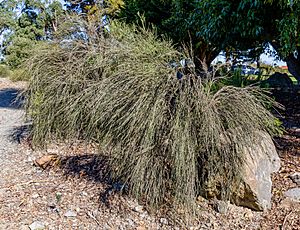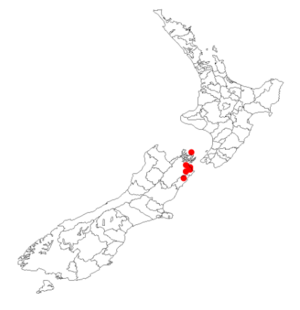Carmichaelia muritai facts for kids
Quick facts for kids Carmichaelia muritai |
|
|---|---|
 |
|
| Conservation status | |
 Nationally Endangered (NZ TCS) |
|
| Scientific classification | |
| Kingdom: | |
| (unranked): | |
| (unranked): | |
| (unranked): | |
| Order: | |
| Family: | |
| Genus: | |
| Species: |
C. muritai
|
| Binomial name | |
| Carmichaelia muritai (A.W.Purdie) Heenan
|
|
 |
|
| Occurrence data from AVH | |
| Synonyms | |
|
Chordospartium muritai A.W.Purdie |
|
Carmichaelia muritai is a special plant also known as the coastal tree broom. It is a type of legume, which means it belongs to the pea family, called Fabaceae. This unique plant can only be found growing in the South Island of New Zealand.
Contents
Where It Lives
This rare plant lives in coastal forests. You can find it especially near Clifford Bay in a region called Marlborough.
Plant Family Tree
Scientists give plants special names to help identify them. This plant was first described in 1985 by a scientist named Andrew Purdie. He first called it Chordospartium muritai. Later, in 1998, another scientist, Peter Heenan, decided it fit better into the group of plants known as Carmichaelia.
Why It Needs Our Help
Carmichaelia muritai is a very rare plant. It is considered to be in danger of disappearing forever.
How Scientists Track Its Safety
In 1998, experts from the IUCN said it was "critically endangered." This means it was facing a very high risk of dying out. At that time, there were only 12 plants left in the wild.
Later, in 2018, New Zealand's own system, the New Zealand Threat Classification System, also listed it as "Nationally endangered." This means it is seriously threatened within New Zealand.
What Threatens This Plant
There are only two small groups of these plants left in nature. Many things are making it hard for them to survive:
- One group is in danger from animals like goats, possums, hares, and rabbits. These animals love to eat every part of the plant.
- This group also faces threats from dry weather (drought), land wearing away (erosion), and other plants (weeds) that grow too close.
- The other group of plants is mainly threatened by fire.


